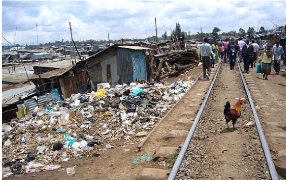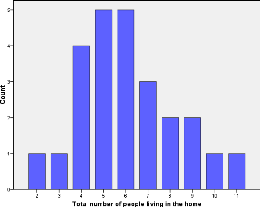4.2.2 The Slum of Kibera
Kibera is known to be one of the largest informal settlements
in East Africa. The term «slums» typically implies live conditions
that are overcrowded with very little access to basic necessities. Electricity,
sanitation, clean water is simply a mere dream for the bulk of the population
living in this environment. According a recent study in the middle of last year
by Stefano Marras, a mapping specialist, the numerical dimension of Kibera is
set between 2.3 and 2.5 sq kilometres and the total population living in the
slum can be most likely estimated to 220,000 and 250,000 people.
Figure 4: A view o the slum of Kibera

4.2.3 The pupils
When asked why children attended private schools in Kibera
rather than walking to one of the five government schools that are situated on
the periphery it seemed that attending a school that was close to the home was
one priority. The pupils in this research all stated that they
travel to school on foot implying that it is important to them and their
parents to live relatively close to their schools. When asked about their homes
pupils said that they consisted of either a single room or there were a maximum
of two rooms. None of the homes had a kitchen and only three homes had access
to an inside toilet. The number of people living in the family home ranged from
two to 11 with a mean of six people (see figure 5).
Figure 5: Number of adult and children living in the
family home

One of the most striking parts of the research brought forward
the fact that in almost all cases, the pupils parents suffered from abject
poverty. When asked if their parents (both father and mother) had a paid job
only three mothers out of the total 25 undertook paid employment. These ranged
from business, cleaner and labourer. The rest of the 22 pupils' mothers are
jobless. Similarly only four of the pupils' fathers undertook paid employment
as labourers, one had died and the remaining 20 have no employment (tables
3&4).
Table 3: Mum has a job
Mum has a paid job
|
Frequency
|
Percent
|
|
yes
|
3
|
12.0
|
|
no
|
22
|
88.0
|
|
Total
|
25
|
100.0
|
Table 4: Father's job
type of job Dad has
|
Frequency
|
Percent
|
|
Died
|
1
|
4.0
|
|
Labourer
|
4
|
16.0
|
|
N/A
|
20
|
80.0
|
|
Total
|
25
|
100.0
|
By implication, most parents in the slum do not have the
financial resources that can enable them to address their offspring's
educational needs. So it is important to address how these parents are able to
pay the school fees in order to attend a private school and why they would do
so. At this effect, George Mikwa argued that:
«In the ending 1980s and 1990s the government and
public schools in Kenya used to implement a cost sharing policy for school
enrolments. The amount per pupils mounted sometimes up to £40 and parents,
who in the greater majority are very poor, raise money for the children
education through crops growing and selling, found it extremely costly. Then
many private schools started operating around the community charging lower
fees... Then the government introduced Free Primary Education in 2003... When
something is said to be free in Kenya, you would expect everybody to be there.
The parents realised that the quality has dropped and thought that it was
better to sacrifice and pay some money in private schools so that their
children could get good education.»
| 

